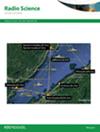使用基于电磁时间反演的方法探测地雷: 1. 经典 TR、迭代 TR、DORT 和 TR-MUSIC
IF 1.5
4区 地球科学
Q3 ASTRONOMY & ASTROPHYSICS
引用次数: 0
摘要
在本文中,我们对已发表的有关使用基于电磁时间反演(EMTR)的地雷定位方法的著作进行了综述和分类。本文研究了利用 EMTR 进行地雷定位的不同方法。具体而言,利用不同的数值技术实现了经典时域 EMTR、迭代 EMTR、EMTR-DORT(Décomposition de l'Opérateur du Retournement Temporel)和 EMTR-MUSIC(多重信号分类)。对上述基于 EMTR 的方法的主要特性进行了评述,在所有评述方法中,TR-MUSIC 方法被选为最有希望解决相关问题的方法。在 TR-MUSIC 方法中,第一步是计算转移矩阵。然后,对传递矩阵进行奇异值分解。最后一步,通过评估伪谱获得地雷的位置。与其他基于 EMTR 的技术相比,TR-MUSIC 具有极高的分辨率(1/10 或更高)和合理的传感器数量,可探测多个紧密间隔的目标。本文章由计算机程序翻译,如有差异,请以英文原文为准。
Landmine detection using electromagnetic time reversalbased methods: 1. classical TR, iterative TR, DORT and TR-MUSIC
In this paper, we present a review and classification of the published works on the use of Electromagnetic Time Reversal (EMTR)-based methods to locate landmines. Different approaches for landmine localization using EMTR are investigated. Specifically, the classical time-domain EMTR, iterative EMTR, EMTR-DORT (Décomposition de l’Opérateur du Retournement Temporel), and EMTR-MUSIC (Multiple SIgnal Classification) are implemented using different numerical techniques. The main properties of the mentioned EMTR-based approaches are reviewed and the TR-MUSIC method is selected as the most promising approach for the problem of interest, among all the reviewed methods. In the TR-MUSIC method, the transfer matrix is calculated in the first step. Then, the singular value decomposition of the transfer matrix is performed. In the last step, the location of the landmines is obtained through the evaluation of the pseudospectrum. As opposed to other EMTR-based techniques, TR-MUSIC features very high resolution (in the order of 1/10 or higher) with a reasonable number of sensors, allowing the detection of multiple closely spaced targets.
求助全文
通过发布文献求助,成功后即可免费获取论文全文。
去求助
来源期刊

Radio Science
工程技术-地球化学与地球物理
CiteScore
3.30
自引率
12.50%
发文量
112
审稿时长
1 months
期刊介绍:
Radio Science (RDS) publishes original scientific contributions on radio-frequency electromagnetic-propagation and its applications. Contributions covering measurement, modelling, prediction and forecasting techniques pertinent to fields and waves - including antennas, signals and systems, the terrestrial and space environment and radio propagation problems in radio astronomy - are welcome. Contributions may address propagation through, interaction with, and remote sensing of structures, geophysical media, plasmas, and materials, as well as the application of radio frequency electromagnetic techniques to remote sensing of the Earth and other bodies in the solar system.
 求助内容:
求助内容: 应助结果提醒方式:
应助结果提醒方式:


